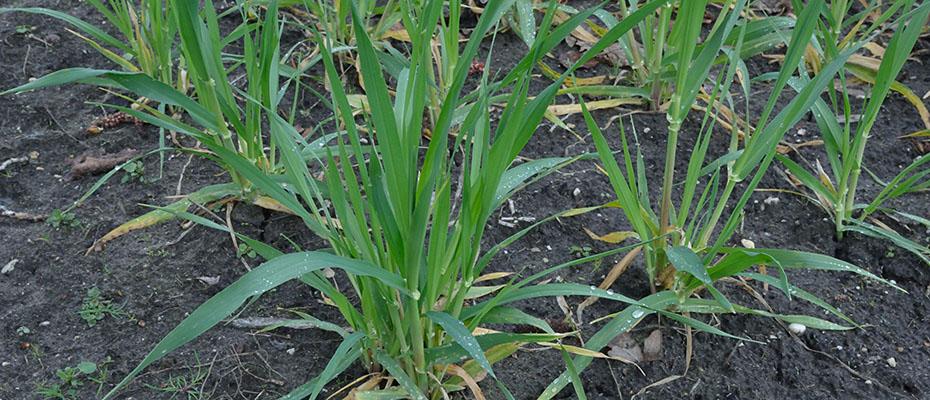Solving the Soil Health Puzzle? We Have you Covered. Cover crops are an important piece to soil health and future profit. We know it takes work and is puzzling at times. Soil First® provides quality products plus tips, tools and solutions to help cover crops work for you. As challenges arise, we are ready with the pieces you need to succeed.

Winter Barley cover crop seed is an upright, cool season annual cereal grain known for its quick growth and low water use. Winter Barley cover crop seed is often used on soils where reclamation and/or rapid soil recovery is the goal.
CHARACTERISTICS:
Non-Forage Benefits:
1 = Poor; 5 = Excellent
Compaction Alleviation: 1
Weed Suppression: 4
Biomass Production: 5
Erosion Control: 4
Disease/Pest Control: 3
Pollinator/Beneficials: 2
P & K Cycling: 3
Ease of Establishment: 4
Nitrogen Fixer/Scavenger: Scavenger
Nutritional Value:
Values Vary Greatly Depending on Maturity
Crude Protein: 9
NEL¹ Mcal/lb.: .57
ADF%²: 37
NDF%³: 65
TDN: 57
DM Tons/Acre: 3-4
Days to First Harvest: Spring
Days to Next Harvest: –
¹- Net Energy for Lactation = Energy available after subtracting digestive and metabolic losses
²- Acid Detergent Fiber = Low values mean more digestible
³- Neutral Detergent Fiber = Low values mean cows can eat more
Ranking (Good, Better, Best):
Graze: Better
Baleage: Good
Chop: Best
SEEDING:
Planting Time:
Aug.-Oct.
Seeding Rate:
Mono (lbs./acre): 30-50
Mix (lbs./acre): 20-40
Forage (lbs./acre): 80-120
Aerial (lbs./acre): 20-60
Seeding Info:
Carbon/Nitrogen Ratio (C:N): Vegetative- 20:1
Seeding Depth (in./with drill): 3/4-1
Seeds/lb.: 14-16,000
Bulk Density (lbs./ft.³): 40
Aerial Application Rate: 20-60
Germination Soil Temp.: 38 F
USDA Hardiness Zone: 6
Days to Emergence: 6-8
MANAGEMENT:
Considerations
-
- Prefers pH 6.0 – 8.5
- Inconsistent at overwintering versus other winter small grains
- Avoid seeding in cold, damp soils
- Winter barley is the most susceptible to winterkill of the cereal grains. Consideration should be made when grazing late into the fall. Barley’s value as a silage crop is the most comparable to whole-plant corn (90-100%).
Fertility
Fertilizer removal rates need to be considered as well. When utilizing cover crops as forage, it’s critical to consider the nutrients being removed along with the biomass. These fertilizer levels will need to be added to ensure maximum nutrient availability for the following cash crop.
Hay Production
Hay yields often average between 2-4 tons/acre. Moisture content should be between 15-20% moisture. Hay quality is more maturity-dependent at harvest than is silage.
The most efficient time to harvest small grain cereals for hay is at early-milk stage. This allows for the greatest compromise between forage yield and quality (quality would be greatest at the late-boot stage). To help speed up drying, a crimper is recommended when harvesting in the late-boot stage
Silage Production
Wheat, barley, oat and triticale silage yields are similar, 4-7 tons/acre of 35% dry matter forage in the boot stage and closer to 6-10 tons/acre when harvested in the late-boot stage. Small grains should be ensiled at between 62–68% moisture. Chop length should be set finer than when harvesting corn or forage sorghum.
(Kansas State University)
- Drought-tolerant; low water use
- Ideal for suppressing weeds when planted at heavier seeding rates
- Captures excessive nutrients left from cash crops
- Silage value resembles whole-plant corn silage
- Reduces some pests in fruit and vegetable crops
- Known suppression to root knot nematode
- Fall forage option (best use –fall pasture, silage and hay)
- Best Use: Fall Pasture; Silage & Hay (boot to dough stage)












